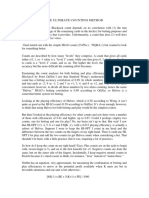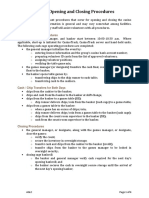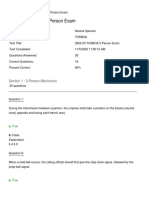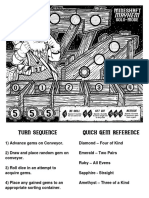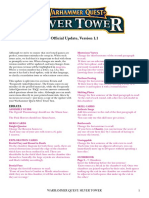Game Protection Procedures
When players buy checks from the dealer, the checks should be stacked in a specific way, so surveillance
can read them clearly. A $100 stack of $5 chips will be broken down into four stacks of five chips. A $500
stack of green chips will be broken down into five stacks of four chips. Whenever a player bets a black
chip, the dealer announces, "black in action," loud enough for the floor supervisor to hear.
When you pay a bet on a game like blackjack, you size into the bet with a small stack of chips, dragging
your fingernail across the tops of the bet and the payoff to show the eye that they are the same size.
A dealer should never go "hand to hand" with chips. If you have to pick up a losing bet from one or two
seat, you pick it up with your left hand, set it down in front of you, then pick it up with your right hand
and go to the rack. You deal out of the right side of your rack, so it is bad form to go straight into the left
side of your rack with chips. A blackjack dealer should never have chips in both hands simultaneously.
First the Stick Person is always looking at the Dealers layout, a task that is doubly hard because he or she
is doing it on both sides of the table. The responsibility of the stick man is to keep his eyes on the dice all
of time. They often double check the payout to make sure it is correct for both the house and the
patron. If this were not enough the Box Person also checks these same things. The dealers are the low
person on the team, and they check them most. Overall that the Pit Boss is also looking to be sure
everything is on the up and up. The eye in the sky looking down at everything that is happening.
In blackjack, as you deal around the table, you rotate your body in the opposite direction of where you
are looking. This is called "walking the game." Dealers must always be on the lookout for players past
posting, picking up losing bets before the dealer can collect them, switching or holding out cards, etc.
The problem is you can only look at one place at a time. If you are paying a bet on first base, you do not
want to turn your back to third base and give that player an opportunity to take a shot at you. We are
trained to have our body facing the opposite direction of our face. So, your body is facing third base
while you are looking at first base.
Casino uniforms do not typically have pockets. At my casino, we were required to wear a small apron to
cover our waste bands. This was to make it harder for us to sneak chips off the game.
Most places have mirrors on the table to allow the dealer to "peek" the cards when there is a ten or an
ace showing. That way, the dealer will not have to pick the cards up off the table, potentially exposing
them to someone at or behind the table.
Players are often not allowed to handle the cards. This is to prevent holding out, switching, or marking
the cards. The players’ hands are to be always in view. A player can hold their cards with one hand. The
cards are changed periodically throughout the day for the same reasons. Dealers are not allowed to take
something out of a player's hand, or hand anything directly to the player, shake a player's hand, etc.
These are just a few examples. There are dozens if not hundreds of other procedures and moves,
especially when you add in craps, roulette, and other games. These procedures are not always followed,
but they are taught. If something goes down on a game and you are not following procedure, it could
cost you your job.
Cheating in casinos has existed since the first gaming establishment opened its doors. Name any casino
game and some crafty person has found a way to cheat. People have used inside knowledge, mechanical
�know-how, sleight of hand and accomplices to gain an advantage. Some casino cheats were caught
immediately, while others enjoyed a 20-year crime spree before getting caught.
In Blackjack, counting cards is probably the most famous way to cheat at blackjack; however, it is not as
easy as the movies would have you believe. First, you must assign a value to every card. Then, you must
keep a running count that is based on the value of the card dealt and calculate the count per deck. Once
you have figured out the count, you can alter your bets to make a profit. Cheating at an online casino
blackjack game is nearly impossible.
Besides bluffing (which is basically lying or “loosely pretending” you have a better hand than you do),
cheating at poker is all about sleight of hand and peeking. If the dealer is in on the scam, then they will
perform a magical sleight of hand trick where you can peek at the cards as they are dealt. The dealer can
also give themselves extra cards and reintroduce them into the deck to give you an advantage later.
Cheating the slot machines is the most common way to beat the casino because of the lack of
supervision and security around the machines. The crudest method of cheating the slot machines has
been using counterfeit money or fake coins (slugs). In the old days (basically any time before 1999),
people would tie a coin to their finger, trip the sensor and then pull the coin back out of the device.
Most electronic gaming machine (EGM) cheats involve a combined knowledge of electronics and the
machines themselves. Using a lock decoder, criminals have picked the lock on the machines or used
electromagnetic pulses to shut off the machine’s electronics, therefore thwarting its defenses.
The State Gaming Control Board (Board) becomes involved to objectively consider all the facts and make
a decision that is fair to both the patron and the casino in settling the disagreement. Under Nevada
Revised Statutes (NRS) § 463.362(1 ): Whenever a licensee refuses payment of alleged winnings to a
patron, the licensee and the patron are unable to resolve the dispute to the satisfaction of the patron
and the dispute involves: (a) At least $500, the licensee shall immediately notify the board; or (b) Less
than $500, the licensee shall inform the patron of his right to request that the board investigate. The
board, through an agent, shall conduct whatever investigation it deems necessary and shall determine
whether payment should be made.
In the end, casino cheating is a high-risk, high-reward proposition. There is a lot of money out there in
the casino industry, and that makes it a very tempting target for those inclined to cheat or scam their
way into riches.
Suspicious about counter plays a method of detecting card counters is to track the customers betting
patterns. A card counter determines cards left in the deck. If the correlation of the condition is below
90% it is not considered card counting.
A player will increase his wager based on true count. When the true count is positive the player will raise
his bet. A manager can identify card counters by their betting patterns. You determine card counters if
the correlation level is above 90%.
�Technical devices can be used for cheating at a casino. There is an apple I-phone which is programed to
count cards. The program calculates true count accurately. The card counting program uses a choice of
fair card counting strategies.
The new program would not be a threat to the casino because of the house percentage is usually low.
The house has and advantage of 2%, an average return of $1 per $100. The player has only 3%
advantage.
If there were a player using this device at your table and you are suspicious about the device being used,
do not detain the devise from the player because you could get bad press and a possible law suit, but
you can request the player leave the phone in his room. It is considered an act of intent to cheat using a
card counting device.
In games like Roulette past posting is a common way to cheat. For example, the dealer takes his eyes off
the layout to watch the ball land on a number. The player near the top of the Roulette wheel player bets
around 0, 00, 1, 2 and 3. The player at the bottom caps his column bets. The player in the middle makes
a bet at the last minute on the number 31 he did not catch. The dealer catches some of the players and
motions quickly to return the bets to the players. If the dealer is suspicious call his supervisor. The
supervisor will call surveillance. Past posting is cheating at a casino.
At a Roulette table had a collection of assorted chips. The larger chips on the outside and the larger
denomination chips on the inside. A player buys in for $500 dollar chips. The dealer marks the chips,
verifies the money, breaks down $5 chips, proves it is the correct amount and passes the chips to the
player. There are chips in an open stack near the player. The player cashes out. He leaves with an extra
three stacks of chips and cashes in for $15,000.
As a dealer you should call you supervisor to run a surveillance check and report it to gaming control.
The best ways to prevent cheating is to take the time to analyze suspicious play, watch players who
consistently win every hand, watch players who bet out of the norm, be sure players are not using illegal
devices on the game, allow investigation to respond to the situation, do a complete shuffle, losing
money is not the only way of getting beat.
In Craps the dice determine the outcome of the play. Dice control the game of Craps. A player come in
at your table, a live table full of action. The dice are lucky. The numbers are consistent. The shooter is
rolling point numbers five times in a row. You begin to get suspicious of the dice. You notice his hands
were not always in view.
�Have your pit boss check the dice when the dice appear to be set. Your supervisor calls surveillance to
track what had happened to report it to gaming control. The player who switched the dice had his hands
out of view of the dealer. The pit boss will change the dice when he sees it is rigged and the game will
continue.
In order to run an efficient game the dealer should evaluate yourself on probabilities, house edge, house
advantage and mathematical advantage, establish the game procedures on time and motion issues,
follow game procedures, establish win, loss, mathematical edge, table limits and standard deviation,
determine gaming outcomes.














































